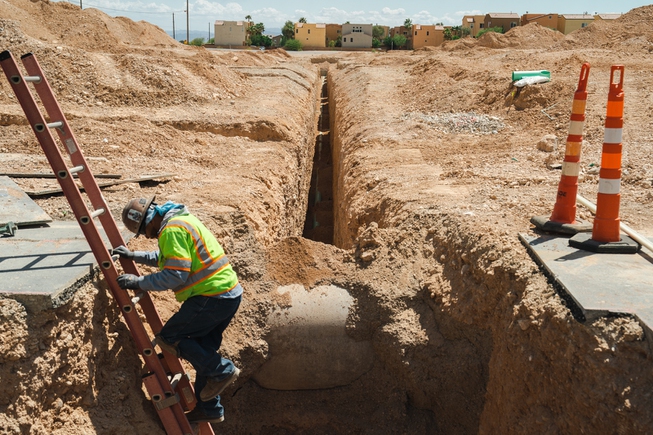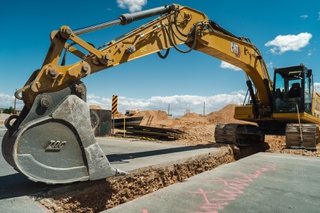
New sewage lines run underground at new subdivision on Chieftain St. and Serene Avenue off of Blue Diamond Road. Platinum Contracting of Nevada, a utility contractor is burying their water, phone and other utility lines for a new residential development, which is more efficient than above ground utilities in Las Vegas, NV. Thursday, May 4, 2023. Brian Ramos
Wednesday, May 17, 2023 | 2 a.m.
Platinum Contracting of Nevada workers are busy this weekday morning at a new housing subdivision in southwest Las Vegas, digging 16-foot trenches that will run under the street for sewer lines along with water, gas, electric and fiber optic infrastructure.
Platinum CEO Dean Gettman said about 95% of his company’s projects involved underground installation of utilities, which he said would last “hundreds of years” as opposed to the above-ground, wooden utility poles, which last either decades or until something befalls them.
Across from the work site are dirt lots at South Chieftain Street and West Serene Avenue, where Gettman could easily point to older above-ground lines that run along Blue Diamond Road. And those aren’t going anywhere anytime soon.
“They were trying to hyperdevelop this entire area. That’s why they ran long stretches of above-ground power; it’s just faster,” Gettman said.
The firm’s underground installations provide connections with NV Energy, Southwest Gas, Cox Communications, CenturyLink and municipal services, it said. Placing utilities underground creates a more efficient and reliable distribution system, reducing the likelihood of outages brought on by weather damage, equipment malfunction, vehicles running into the poles and even power grid attacks from terrorists, underground utility advocates say.
The installation can be a solution for utilities looking to reduce outages while at the same time producing clean energy, Gettman said. With many residents shifting to solar power at their homes and driving electric vehicles, a reliable power grid to support clean energy is required, he said.
Platinum said cities that already have underground utility strategies, such as Fort Collins, Colo., and Anaheim, Calif., have a 99.9% reliability rate and a 97% reduction in electric outage minutes.
Platinum also has ongoing installation at Lake Las Vegas in Henderson and with developments led by the Howard Hughes Corp. in Summerlin. Platinum has completed more than 30 underground projects this year for both commercial and residential developments.
They expect the demand to go underground will increase with the rollout of federal programs like the bipartisan Infrastructure Investment and Jobs Act, Inflation Reduction Act, and the Broadband Equity, Access and Deployment Program. The broadband program is providing $42.45 billion nationwide to expand high-speed internet through infrastructure deployment and adoption programs.
Gettman said NV Energy designs systems that contractors use to install electric infrastructure. Newer systems, he said, are designed with modern-day needs — such as home electric vehicle charging stations — in mind.
“A lot of the newer homes come with (those) already built in the garage,” Gettman said. “Knowing that ahead of time, the systems are just designed for that demand. The older systems just aren’t.”
Those older systems, with electricity largely delivered along above-ground poles and wires, still exist in older, more-established neighborhoods, places where no developers have come through over the decades and buried the lines as part of a new project.
Mike Hudgeons, engineering and construction services manager for the city of North Las Vegas, said that’s how most existing lines get buried. Hudgeons also said the North Las Vegas City Council made that a requirement for residential developers looking to build north of Craig Road within city limits to put utilities underground.
“Say they’re at the corner, and there’s some overhead (utilities), it’s their responsibility to underground that just to try to clean areas up and get everything that we can underground,” Hudgeons said.
Dale Daffern, director of public works for North Las Vegas, said most homes with overhead utilities in North Las Vegas were south of Lake Mead Boulevard, in neighborhoods dating to the 1960s or older. Some utility setups are more complicated, and therefore more expensive to replace, he said.
“It’s a tough deal to underground in neighborhoods where they may have easements or alleyways with poles running behind the homes, and then individually connecting to the homes,” Daffern said. “You’d have to… go out into the roadway (and retrench) every individual house.”
He said that while overhead power lines were mostly considered an eyesore, there were more pressing infrastructure needs — such as switching out old light bulbs on streetlights for LEDs.
“We have quite a bit of our streetlight poles that get hit, and some of the older streetlight poles have overhead power on them also,” Daffern said. “And it’ll take down the system when one of those gets knocked down or damaged.”
He said the city typically tried to get developers to bury utility lines when their projects are near overhead sites. The city also evenly split the $1 million cost of undergrounding power lines along a mile-long stretch of Decatur Boulevard from West Lone Mountain Road to West Ann Road with NV Energy.
“It’s been a few years, and they’re still working on lowering it actually,” Daffern said. “It’s actually a pretty daunting task to drop that kind of power.”
“Everything pretty much south of Craig Road, we haven’t lowered the power, but everything north of Craig Road, we’ve worked to get them underground,” Daffern said.
Danyale Howard, director of NV Energy’s natural disaster protection program, said the utility would keep overhead lines in place unless the equipment needed an upgrade or local city codes required undergrounding.
Across the U.S., there are an estimated 75,000 vehicle collisions with utility poles each year, the National Cooperative Highway Research Cooperative reported in a 2020 study. Utility poles are second only to trees as the most commonly struck fixed object in fatal crashes on the nation’s highways in recent years, according to the National Highway Traffic Safety Administration.
Howard said wildfires and monsoons are the two most prominent natural threats to overhead lines in Southern Nevada.
Since 2020 the utility has started rebuilding or reinforcing lines at key points where models predict those events could take out power lines and worsen a natural disaster.
But burying stretches of above-ground lines would be an expensive project, she said.
In California, for example, Pacific Gas & Electric plans to bury 10,000 miles of power lines to limit wildfire risk — but it won’t come cheap. Each mile of transmission line would cost $2 million for an estimated total cost of $20 billion, according to the Institute for Energy Research.

